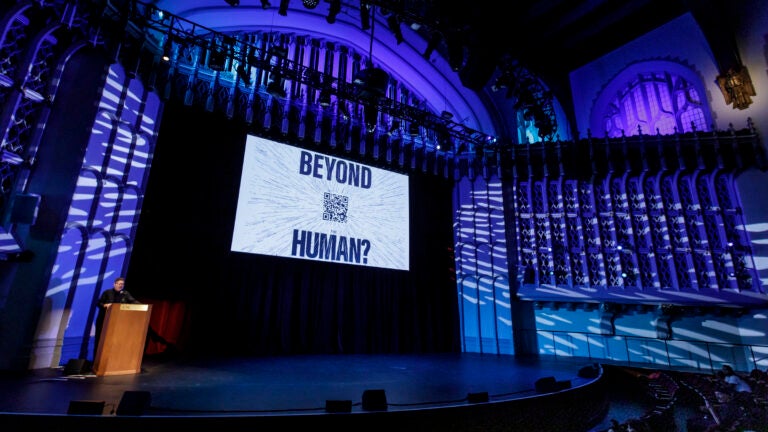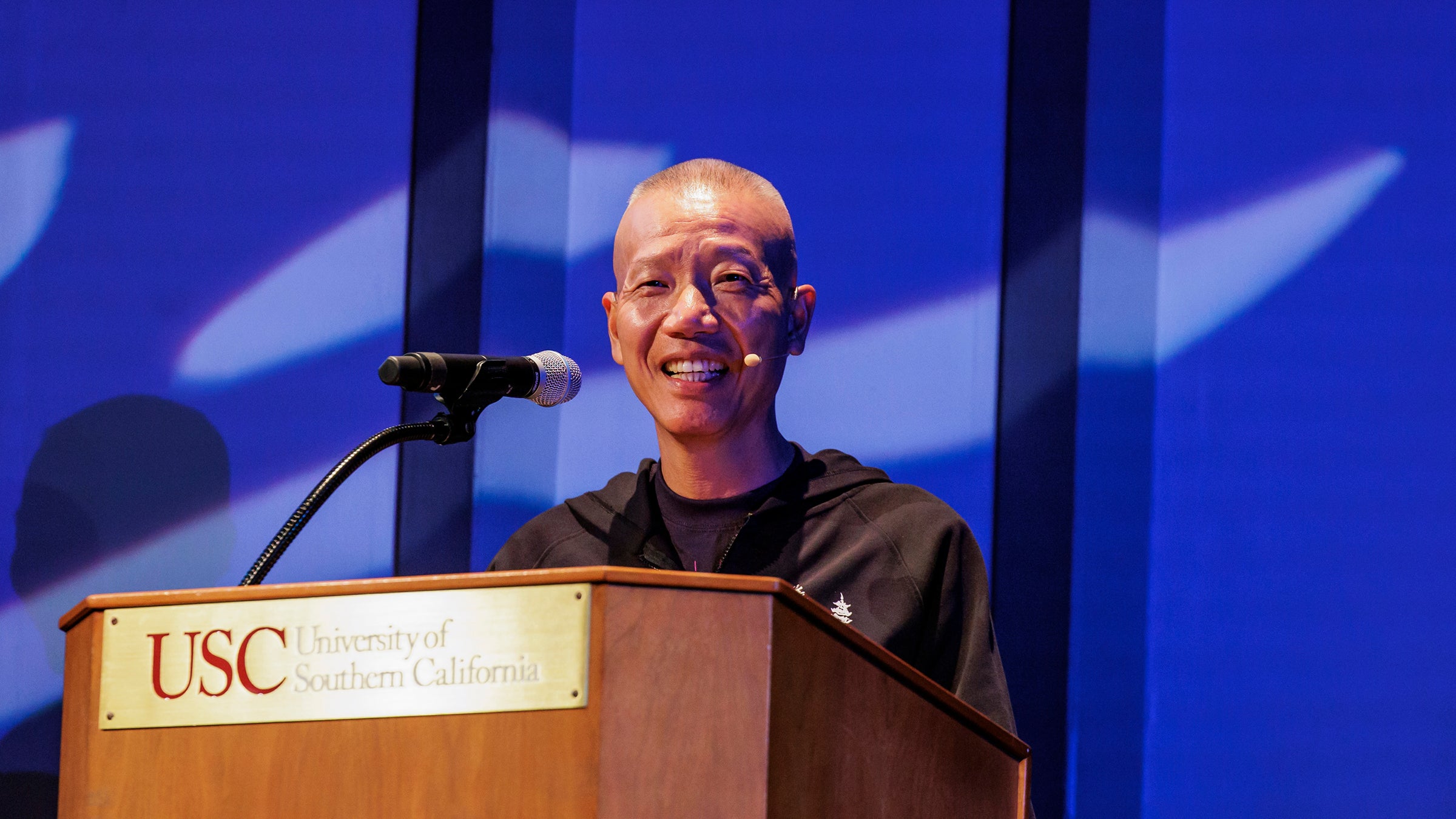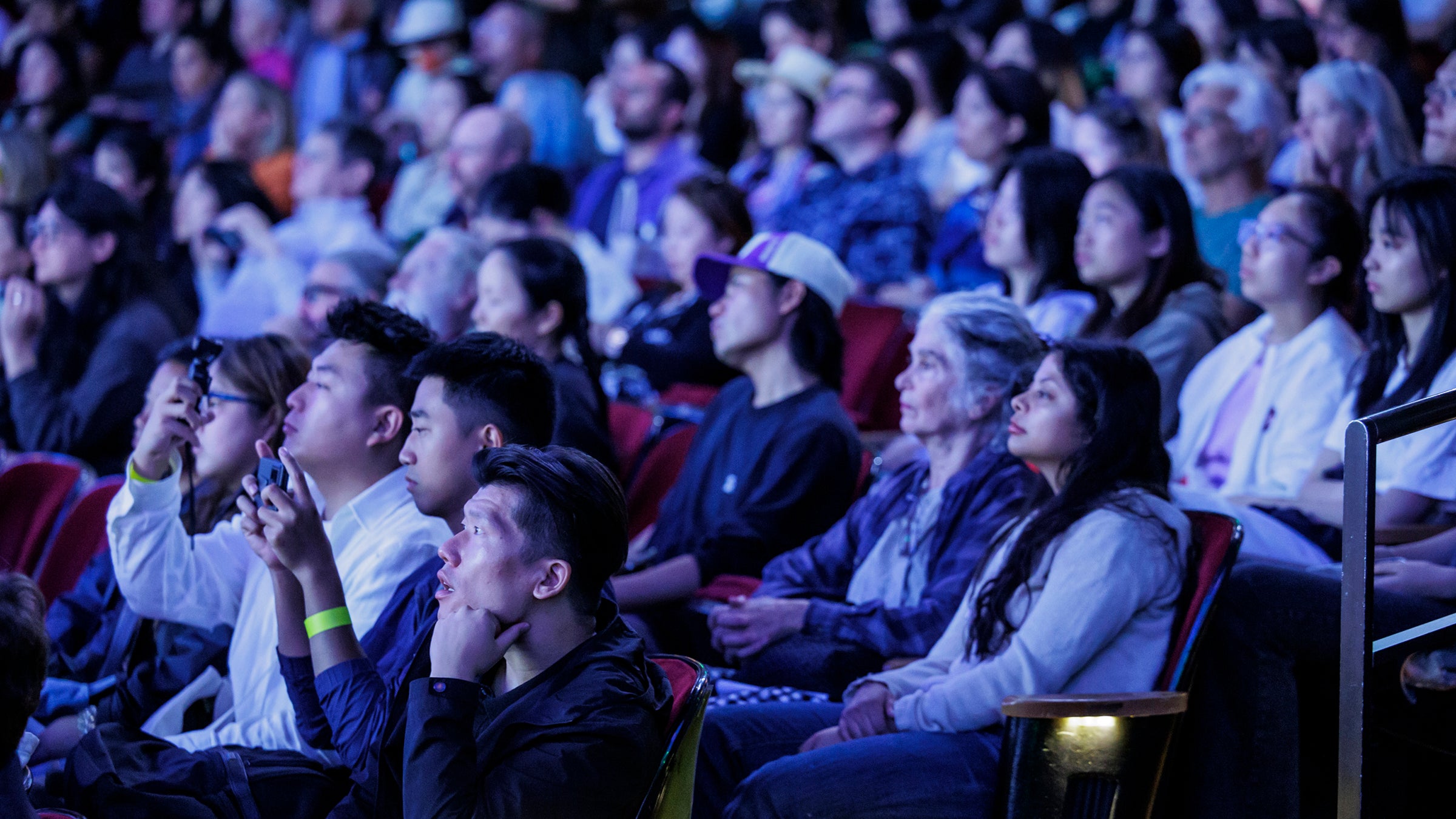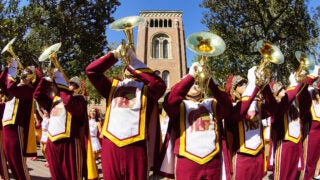
Josh Kun closes out the “Beyond the Human?: From the Metaphysical to the Physical” symposium. (USC Photo/David Sprague)
Groundbreaking symposium explores the impact of AI on the arts
A talk by renowned contemporary artist Cai Guo-Qiang and lunch cooked by robots were among the highlights of the provocative event at USC.
When artist Cai Guo-Qiang stepped to the podium at Bovard Auditorium on the USC University Park Campus on Monday, he shared the stage with a surprise guest: an AI system he developed named “Buddha.”
With a pair of robotic arms linked to a trio of computer monitors set atop two canvas basket trucks, Buddha looked like a high-tech sculpture. When Cai addressed the audience in Chinese, Buddha served as translator, speaking in English in a tone indistinguishable from Cai’s own voice. The intelligent system’s robotic arms moved as if conducting a phantom symphony, their mirrored tips reflecting violet light that danced across the stage.
The cooperation between artist and machine was a fitting opener to the daylong symposium “Beyond the Human?: From the Metaphysical to the Physical,” co-curated by Cai and USC Vice Provost for the Arts Josh Kun and co-sponsored by USC Visions and Voices and the USC Center for Generative AI and Society. Speakers and performers from visual art, dance, technology, literature, architecture, film and music converged around artistic, sociocultural and ethical questions raised by the emergence of generative AI and autonomous robots.
“[Buddha] is a perfect example of what we are here to talk about today: the human and the post-human, the thrill and peril of machine learning that can take on a life of its own, building its own self-contained civilizations, its own ideas of language, spirit and faith,” Kun said in his welcome remarks.
Attended by roughly 500 people, the symposium was the first public event of USC Arts Now, a new arts initiative launched by USC President Carol Folt and overseen by Kun to nurture arts collaborations across the health sciences, computing and other disciplines. “Our goal is to inspire all students, no matter the field, to engage with the arts as a way of being and thinking,” Kun said.
AI and the arts: The end of the artist?
An internationally renowned artist who designed the pyrotechnics for the 2008 Beijing Summer Olympics, Cai is known for incorporating explosive materials, including gunpowder and fireworks, into his art. He’s also a pioneer in using AI in his artistic process.
Some symposium attendees — like Yin Li of Seattle, who works as an intern at an AI company — traveled a great distance to hear Cai speak. “I am really curious about the technical aspect of Cai’s work,” Li said.

Cai took the audience behind the curtain of his technical wizardry. He explained that Buddha is one of the many personas of an AI model he developed called cAI (pronounced AI Cai) that he employs to co-create his paintings and events.
“[cAI] deeply learns from my artworks, archives and areas of interest,” Cai said. “It also studies historical and contemporary figures I admire. … These different personas debate among themselves, forming a free and independent community.”
By asking his team of AI assistants a series of prompts, Cai draws out textual and visual inspiration for his larger-than-life pyrotechnic designs. He also calls upon mechanical arms powered by cAI to do some of the physical work of painting. The system can respond to live human feedback and even create paintings independently.
“Recently, after my guidance, it collaborated with me to paint my grandparents’ wedding portrait,” Cai said. “That was my grandma’s dying wish for me.” The portrait is currently on display at the USC Pacific Asia Museum in the PST ART exhibition Cai Guo-Qiang: A Material Odyssey, which opened Tuesday and runs through June 15.
Cai’s discussion went to the heart of one of the symposium’s fundamental questions: What is the artist’s role in a computational future? Cai brushed aside concerns that AI will replace human artists, emphasizing the positive aspects of the technology as a tool for expanding artistic possibilities and evoking childlike curiosity.
“If an artist can be replaced by AI, it probably means that the artist should lose their job in the first place,” Cai said.
Trojans pushing boundaries
Among the day’s participants were several USC faculty members working at the cusp of art, design and AI.
Burçin Becerik-Gerber, professor and chair of the Sonny Astani Department of Civil and Environmental Engineering in the USC Viterbi School of Engineering, presented her pioneering work in the field of human/building interaction. Her research explores the integration of AI into the design and operation of intelligent buildings that are responsive and adaptive to the needs of their occupants. She has found that personalized adjustments to building factors including light, temperature, space and color can profoundly affect people’s productivity, health and well-being.
“We [can] envision our buildings as more than just structures — perhaps as machines, teammates, co-workers or even friends,” Becerik-Gerber said.

But she cautioned that even as AI can improve built environments, it also creates a new set of problems that must be considered. Among them are privacy concerns that the technology introduces into everyday spaces and environmental drawbacks, as AI systems require considerable power and water resources.
Aroussiak Gabrielian, assistant professor of landscape architecture and urbanism in the USC School of Architecture and director of the Landscape Futures Lab, spoke about her design projects investigating human and nonhuman interactions for more sustainable and equitable futures. The environmental artist and biodesigner is “interested in asking how AI systems might be built differently, and how they might function if they centered and were modeled not on human intelligence, but rather on plant intelligence,” she said.
Interspersed throughout the presentations were short videos showcasing some of the diverse AI tools and techniques artists use to create moving image artworks. The videos were curated by Holly Willis, professor of cinematic arts and chair of the media arts and practice division in the USC School of Cinematic Arts and co-director of the Center for Generative AI and Society.
Ruolan Wu, a USC sophomore studying media arts and practice who attended the symposium, appreciated how the event opened her eyes to various intriguing ways to use AI technology in artistic endeavors. “This experience has been very formative, and I think it helps me more clearly define some of the ways we can approach AI,” Wu said.
AI and the arts: Robot encounters
Wu also raved about the food served at lunch, which was provided by Tigawok and cooked by three Next Robot AI Cooking Robots. The AI was programmed to control all elements of the cooking. Humans were needed only to toss ingredients into the automated stir-fry pot, a sort of cauldron that spun the food like laundry in a washing machine. The menu included braised pork belly and quail eggs, Brussels sprouts, orange peel chicken, and sweet tomato and scrambled eggs.
Earlier in the day, Catie Cuan, a postdoctoral scientist in computer science at Stanford University, spoke about her work empowering people to feel comfortable interacting with autonomous robots through movement. A professional dancer, Cuan is a pioneer in choreorobotics, which uses insights from dance to program robots that move in more naturalistic and responsive ways. Challenging standard narratives of these machines as either utilitarian or destructive, she aims to open the door to a future with robots “that’s creative, unstructured, intuitive and fun,” she said.
Christopher Luis, who graduated from USC in May with degrees in economics and mathematics, was struck by videos Cuan showed of robots moving in choreographed ways and responding to human gestures. “These robots express themselves in a way that is reminiscent of human culture,” Luis said.
The complexities explored throughout the symposium were perhaps best summed up by afternoon presenter Kira Xonorika, an artist who uses AI to delve into complex themes relating to ancestry, Indigenous worldviews and the critique of gender binaries. “[AI] can be playful,” Xonorika said. “It can be colorful. And it can be a moment of deep introspection.”



